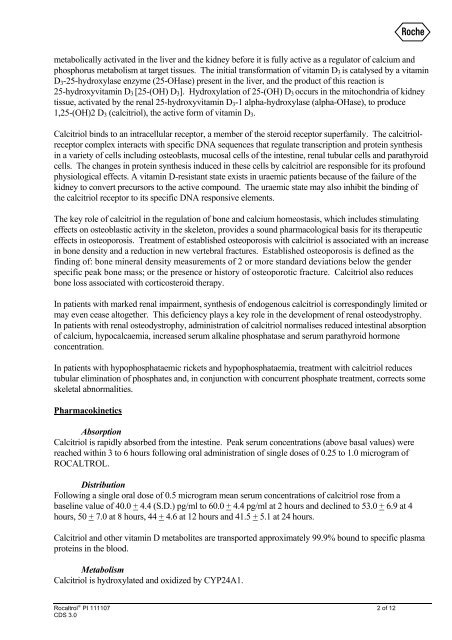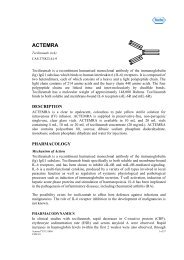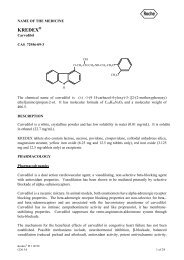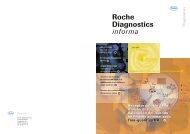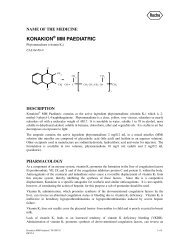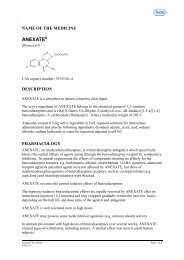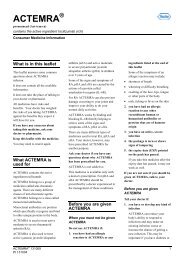Rocaltrol (calcitriol) - Product Information (PI) - Roche Australia
Rocaltrol (calcitriol) - Product Information (PI) - Roche Australia
Rocaltrol (calcitriol) - Product Information (PI) - Roche Australia
Create successful ePaper yourself
Turn your PDF publications into a flip-book with our unique Google optimized e-Paper software.
R<br />
metabolically activated in the liver and the kidney before it is fully active as a regulator of calcium and<br />
phosphorus metabolism at target tissues. The initial transformation of vitamin D 3 is catalysed by a vitamin<br />
D 3 -25-hydroxylase enzyme (25-OHase) present in the liver, and the product of this reaction is<br />
25-hydroxyvitamin D 3 [25-(OH) D 3 ]. Hydroxylation of 25-(OH) D 3 occurs in the mitochondria of kidney<br />
tissue, activated by the renal 25-hydroxyvitamin D 3 -1 alpha-hydroxylase (alpha-OHase), to produce<br />
1,25-(OH)2 D 3 (<strong>calcitriol</strong>), the active form of vitamin D 3 .<br />
Calcitriol binds to an intracellular receptor, a member of the steroid receptor superfamily. The <strong>calcitriol</strong>receptor<br />
complex interacts with specific DNA sequences that regulate transcription and protein synthesis<br />
in a variety of cells including osteoblasts, mucosal cells of the intestine, renal tubular cells and parathyroid<br />
cells. The changes in protein synthesis induced in these cells by <strong>calcitriol</strong> are responsible for its profound<br />
physiological effects. A vitamin D-resistant state exists in uraemic patients because of the failure of the<br />
kidney to convert precursors to the active compound. The uraemic state may also inhibit the binding of<br />
the <strong>calcitriol</strong> receptor to its specific DNA responsive elements.<br />
The key role of <strong>calcitriol</strong> in the regulation of bone and calcium homeostasis, which includes stimulating<br />
effects on osteoblastic activity in the skeleton, provides a sound pharmacological basis for its therapeutic<br />
effects in osteoporosis. Treatment of established osteoporosis with <strong>calcitriol</strong> is associated with an increase<br />
in bone density and a reduction in new vertebral fractures. Established osteoporosis is defined as the<br />
finding of: bone mineral density measurements of 2 or more standard deviations below the gender<br />
specific peak bone mass; or the presence or history of osteoporotic fracture. Calcitriol also reduces<br />
bone loss associated with corticosteroid therapy.<br />
In patients with marked renal impairment, synthesis of endogenous <strong>calcitriol</strong> is correspondingly limited or<br />
may even cease altogether. This deficiency plays a key role in the development of renal osteodystrophy.<br />
In patients with renal osteodystrophy, administration of <strong>calcitriol</strong> normalises reduced intestinal absorption<br />
of calcium, hypocalcaemia, increased serum alkaline phosphatase and serum parathyroid hormone<br />
concentration.<br />
In patients with hypophosphataemic rickets and hypophosphataemia, treatment with <strong>calcitriol</strong> reduces<br />
tubular elimination of phosphates and, in conjunction with concurrent phosphate treatment, corrects some<br />
skeletal abnormalities.<br />
Pharmacokinetics<br />
Absorption<br />
Calcitriol is rapidly absorbed from the intestine. Peak serum concentrations (above basal values) were<br />
reached within 3 to 6 hours following oral administration of single doses of 0.25 to 1.0 microgram of<br />
ROCALTROL.<br />
Distribution<br />
Following a single oral dose of 0.5 microgram mean serum concentrations of <strong>calcitriol</strong> rose from a<br />
baseline value of 40.0 + 4.4 (S.D.) pg/ml to 60.0 + 4.4 pg/ml at 2 hours and declined to 53.0 + 6.9 at 4<br />
hours, 50 + 7.0 at 8 hours, 44 + 4.6 at 12 hours and 41.5 + 5.1 at 24 hours.<br />
Calcitriol and other vitamin D metabolites are transported approximately 99.9% bound to specific plasma<br />
proteins in the blood.<br />
Metabolism<br />
Calcitriol is hydroxylated and oxidized by CYP24A1.<br />
<strong>Rocaltrol</strong> ® <strong>PI</strong> 111107 2 of 12<br />
CDS 3.0


